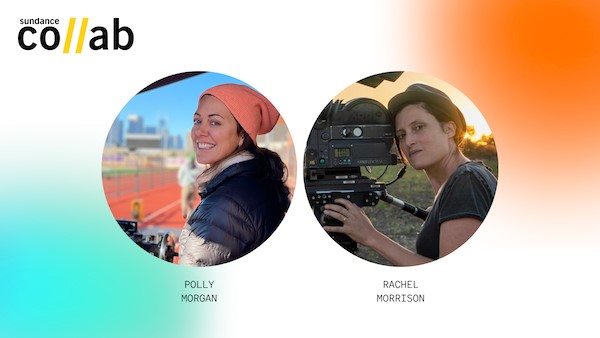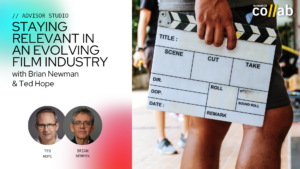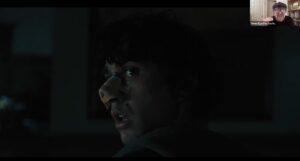By Stephanie Ornelas
2018 was a year of progress for the field of cinematography. Rachel Morrison (Fruitvale Station, Dope) made Oscar history when she became the first woman ever to be nominated for Best Achievement in Cinematography for her work on Mudbound. That same year, Polly Morgan (The Woman King) became the first (and only) woman to join both the ASC (American Society of Cinematographers) and BSC (British Society of Cinematographers). Although cinematography is widely known as a male-dominated role in the film industry, artists like Morgan and Morrison are claiming their space — and paving the way for more women DPs to do the same.
The two cinematographers recently gathered virtually to speak at Sundance Collab’s Advisor Studio: Navigating a Career as a Cinematographer, and they had a lot of valuable advice to share with participants. From balancing different personalities during production to finding your voice on set, here are seven tips from the hour-long discussion:
Build a community of filmmakers
Morgan explains how it’s not uncommon for cinematographers, who are just getting started, to pick up projects for little to no pay as they network and develop relationships in the industry.
“I think what you need to do is build a community of filmmakers that you can collaborate with, and try slowly to build on your reel,” she advises. “Because, ultimately, your work is going to get other work. So you just want to try and shoot whatever you can. Get yourself out there and meet people.
“I know from experience that when you’re going to work somewhere for free, they also want you to probably bring the camera and the lights and kind of do everything for them for very little money,” Morgan continues. “I kind of shot whatever I could. If I could use one or two shots in my reel, I was able to show more breadth to my work. Then, every time I worked on something, I would meet new people, and they would pass my name on. It was just a slow process of growing my body of work and building my relationships.”
Be specific with your genre of choice
Morrison also advises cinematographers to really hone in on the genre they are most passionate about. A lover of drama, she herself strived to always work within that genre in some capacity.
“The more specific you can be and [the more you can] build a body of work that speaks to the kind of work you want to do,” explains Morrison. “It’s also a sales tool so that you’re not getting pigeon-holed shooting something you didn’t want to be shooting in the first place. Specifically within cinematography, what are you driven towards?”
Utilize social media
Both Morgan and Morrison agree that social media can be very useful for marketing yourself and your work, and they encourage aspiring DPs to utilize this new way of networking.
“I didn’t have social media to market myself or to communicate with other filmmakers when I was starting out,” says Morgan. “Social media can be a really great tool to reach out to directors that you admire or that you might want to work with. Just do the research and then try and get in their sphere if you can.”
Understand that every director will be different
“Whether it’s film or TV, the one thing that you can guarantee is that every director you work with will have a different process,” says Morgan. “I’ve worked with directors on movies where I haven’t even really talked through the whole script with them. And I’ve worked with other directors where we’ve talked through every single scene and about the visual language in a very specific way.”
Because of this, Morgan explains how it’s crucial that cinematographers stay prepared for anything.
“Then it’s all about the schedule and how I work with the [assistant director] in order to make sure that [it] works for me and the director,” adds Morgan. “It’s really important for you to work quickly in order to give the director as much time as possible with the actors. Things will not go well if you take a phenomenally long time to set stuff up. If you can, work with natural light as much as possible. It’s about making sure that your team is prepared and on the same page. So much of my work is about relationships and communication. You have to find a way to navigate through all different types of personalities.”
Pick your battles…
Something Morrison underlines more than once is that it’s important that cinematographers be selective when it comes to making certain requests during production.
“If you’re constantly asking for more time, more money, more gear, at some point, nobody’s gonna fight that fight with you,” she explains. “But if you kind of go with production, if you’re very accommodating, then you say you really need a technocrane on this day, and this is why, they’re much more willing to work with you. If you pick your battles and you know when something’s worth fighting for, I think you just get a lot more traction that way.”
… but make sure your voice is heard
And, speaking of things worth fighting for, Morgan and Morrison agree that cinematographers should have a say when it comes to location scouting and when it’s time to bring on a colorist during post-production.
“It’s really important to have a voice in choosing the colorist. Hopefully [producers and directors] will look to you, but sometimes producers like to choose the colorist for financial reasons,” says Morgan. “It’s such an important part of the cinematographer’s work, and even the director’s work, to carry the vision through. You just want to make sure that your relationship with that colorist is a good one and that they have your back.”
When it comes to scouting locations, Morrison stresses that’s also something a cinematographer needs to be consulted about.
“The first conversation I have with the location scout is, ‘If we know we’re shooting widescreen, please look at things widescreen and take pictures of things widescreen.’ It’s no use to me [showing me] these vertical pictures for a film that I’m about to shoot widescreen. Let them know what to be looking for. Set out your intention for them to scout with you in mind so that they’re not spinning their wheels trying to imagine what your vision for the film is.”
Have a work-life balance
The idea of having a work-life balance can sometimes seem impossible when you’re in the world of independent filmmaking, but without it, Morrison says “you’re too burnt out to do your best work anyway.”
Both Morgan and Morrison offer unique perspectives when it comes to balancing a demanding career and making time for self care. They advise participants, while you definitely have to work hard to get your foot in the door, don’t get too sucked up in working all the time.
“At the end of the day, that’s not your whole life. For me, I always wanted kids,” explains Morrison. “It was a really hard decision to make in this career, and it’s the best thing I ever could have done for myself. I can still tell you all the movies that I couldn’t [make] because of giving birth, being pregnant. But would I change any of that? Not in a heartbeat. And even for people who don’t have or want kids, I think the self care component is really important. As soon as I drop down in any city, I find the nearest boxing gym. Whatever your outlet is, make sure you carve that space out for yourself.”
To get more insight into the world of cinematography, sign up for Sundance Collab and check out the full recording, and an exclusive Q&A, of Advisor Studio: Navigating a Career as a Cinematographer with Polly Morgan, ASC, BSC and Rachel Morrison, ASC. Be sure to also check out Collab’s other Advisor Studios, including Financial Planning for Creatives: From Taxes to Retirement with Creative Capital.










